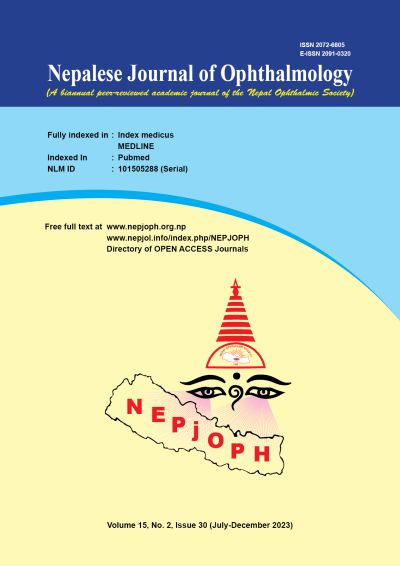Assessment of Knowledge of Parents of Children with Cortical Visual Impairment: An Interventional Study
DOI:
https://doi.org/10.3126/nepjoph.v15i2.57263Keywords:
Cortical visual impairment, knowledge, parent educationAbstract
Introduction: The cornerstone of CVI management is developing methods to help the kid, caregiver and educator comprehend how the child uses their vision and how modifications may be made to help the child use it more effectively.
Objectives: To evaluate caregivers' and parents' understanding of cortical visual impairment and how it evolves after receiving educational materials in the form of video and handout.
Materials and methods: This prospective interventional study enrolled all children with CVI at a tertiary eye care center from 2020 February to 2021 January. Parents were interviewed about CVI visual behaviour using a Perkins website consulting interview. They were then sensitised with a Nepali video and handout describing CVI characteristics. A follow-up visit or call was scheduled six weeks later to reassess their knowledge.
Results: In the study, 37 parents participated. Before the intervention, 81.1% (n = 30) were unaware of CVI, which decreased significantly to 4.3% (n = 1) after intervention (p <0.001). For the follow-up, 59.4% (n = 22) of parents participated or responded to calls. Initially, 43.2% (n = 16) of parents attributed issues to eye problems, increasing to 90.9% (n = 20) recognising the brain's role after education (p = 0.021). Notice of attraction to bright colors increased from 48.6% (n = 18) to 86.4% (n = 19) post-education. Awareness of children's favourite toys rose from 62.2% (n = 23) to 81.8% (n =19) in the follow-up. Additionally, noticing better vision in one room over another increased from 24.2% (n = 9) to 40.9% (n = 9) post-education. Movement was reported as good in familiar environments by 81.1% (n = 30), with 70.3% (n = 26) facing issues in unfamiliar ones, consistent in the follow-up.
Conclusion: The study found that educating primary caregivers with handouts and videos alone did not effectively improve their understanding of the disease, likely due to factors such as parental literacy and socio-economic status. Consequently, establishing nationwide CVI clinics is urgently needed.
Downloads
Downloads
Published
How to Cite
Issue
Section
License
Copyright (c) 2023 Nepalese Journal of Ophthalmology

This work is licensed under a Creative Commons Attribution-NonCommercial-NoDerivatives 4.0 International License.
This license enables reusers to copy and distribute the material in any medium or format in unadapted form only, for noncommercial purposes only, and only so long as attribution is given to the creator.




